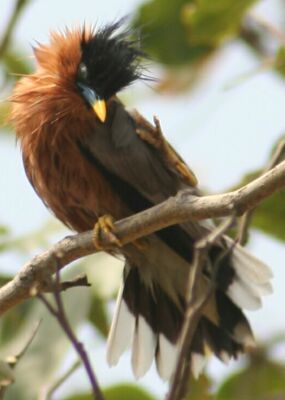

This is a narrative of birds commonly encountered at IIT Kanpur. The campus may be particularly attractive for birds since it is a virtual oasis of green amid the surrounding agricultural land; this checklist lists 259 bird species that have been sighted around here.
I am no bird expert. Until some years ago, I didn't know a cattle egret from a little green bee-eater. The birds shown here are not rare or special - they are just everyday birds, birds that may drop in at your lawn. Most were photographed while walking around my house, but many are from other areas such as the orchard behind the airstrip and the reservoir near it, or the barA nahar (Ganga Canal). See more on bird-sighting spots at IITK below.
While most of the images are nearabout the IIT campus, these birds are actually common across most of Northern India (Gangetic plains), and some are common much beyond. As one goes West, things get drier, and birds like the drongo or the pied myna become rarer.
If you come across an exceptionally artistic picture, it is probably the work of Sainath Vellal, who did his Master's here 2006-2008. Some other pictures have also been contributed (see below), and do let me know if you would like to contribute any pictures here. (amit [AT] iitk.ac.in).
Those from IITK may visit the page [Birds of IIT Kanpur] created by Prof. TV Prabhakar, which lists more than two hundred species that have been seen at IITK, incorporating the descriptions from the Book of Indian birds as well as non-IITK photographs. Unfortunately this page is not available outside IITK, but I have updated and made an HTML version of the checklist that was originally created in the 70s by Raman Athreya and others, as well as this PDF version which includes the local (Hindi) names. Note that abour 50 of the bird species are from Bithoor on the Ganga and are typically not encountered on campus. A more recent attempt at creating a list, by Sainath and Suhail, may be found here. See more links below.
Yet I didn't know its name for nearly a decade at IITK. Hindi legend has it that the babbler flocks are mostly females - which is why they are known as sAt bahin (seven sisters). But perhaps that has more to do with how they are forever squabbling and fighting - wrestling pairs from a group will pin each other to the ground in a flurry of claw and feathers. You can hear them uttering a single intermittent "squaw" through the day, but often they make other calls as well.
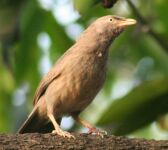 In particular, when a cat or a snake is near, they go into a
frenzy hurling invective at the intruder (Click on the adjacent image
for the photo-story of What the Babblers think of the Cat... )
In particular, when a cat or a snake is near, they go into a
frenzy hurling invective at the intruder (Click on the adjacent image
for the photo-story of What the Babblers think of the Cat... )
Birds, like everything around us, hold more interest as they are more uncommon. This is as it should be, since non-surprising phenomena contain less information. But I realized it firsthand when I found myself reluctant to turn the camera onto babblers, despite their fascinating social behaviour.
In the middle image,
Notice how much birds can inflate when
they breathe! (Click on images to enlarge)
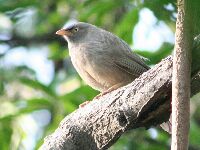
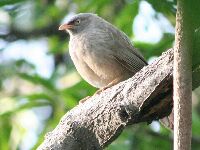
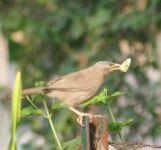
Barbet
Barbets are small-ish birds, about Bulbul size, with a large head and a broad
beak, often seen on trees that are fruiting. The
crimson-breasted barbet,
also called "Coppersmith Barbet",
with a black eyestripe and crimson and green colouration, is
very common, the large green barbet with its big yellow eye is also
commonly seen in urban parks. Since the birds are small though, it helps if
one is looking through a binocular.
These birds (size:Myna-) visited my garden in small groups of 2 or 3 about
twice
a week or so through the pre-winter flowering season. The brilliantly
coloured crimson-breasted variety is quite
common across India, even in urban areas.
Crimson-Breasted Barbet
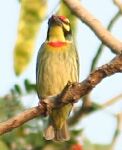
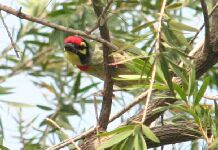
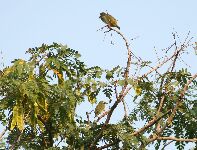
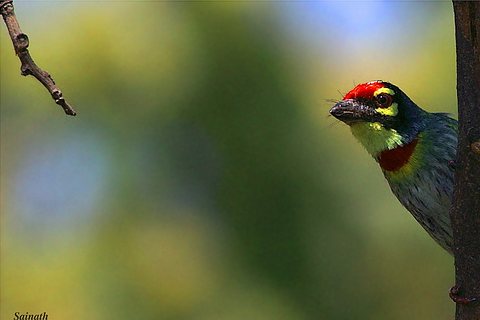
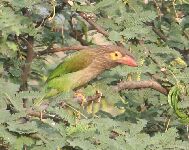
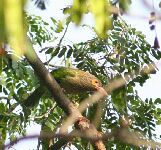
You can see bee-eaters in most open spaces, sitting on wires, and tall reeds of grasses, their tail having the distinctive thin wire-like bit coming out in the middle. They are amazingly acrobatic, catching insects on the wing. They'll often be sitting on the wires; near the airstrip is a good bet. The first two images are from Sainath (you can tell from the quality).
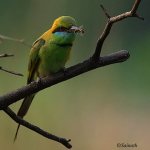
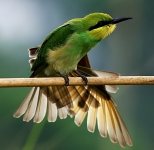
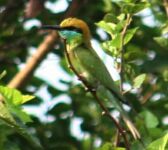
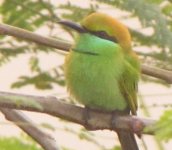 And now, one more amazing capture by Sainath. The bee-eater on the right
looks on jealously while the other gobbles his catch :
And now, one more amazing capture by Sainath. The bee-eater on the right
looks on jealously while the other gobbles his catch :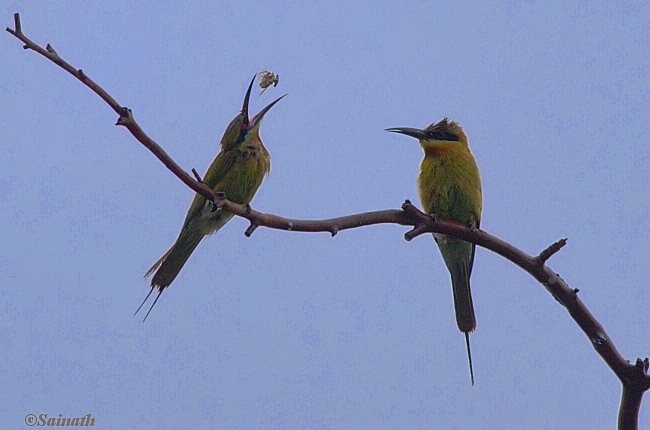
Red-vented Bulbul
Here is a red-vented bulbul looking royal on a palm tree outside Park Royal
hotel in the urban congestion of Nehru Place, Delhi. Notice the black
crest and the naughty gleam in his eye:
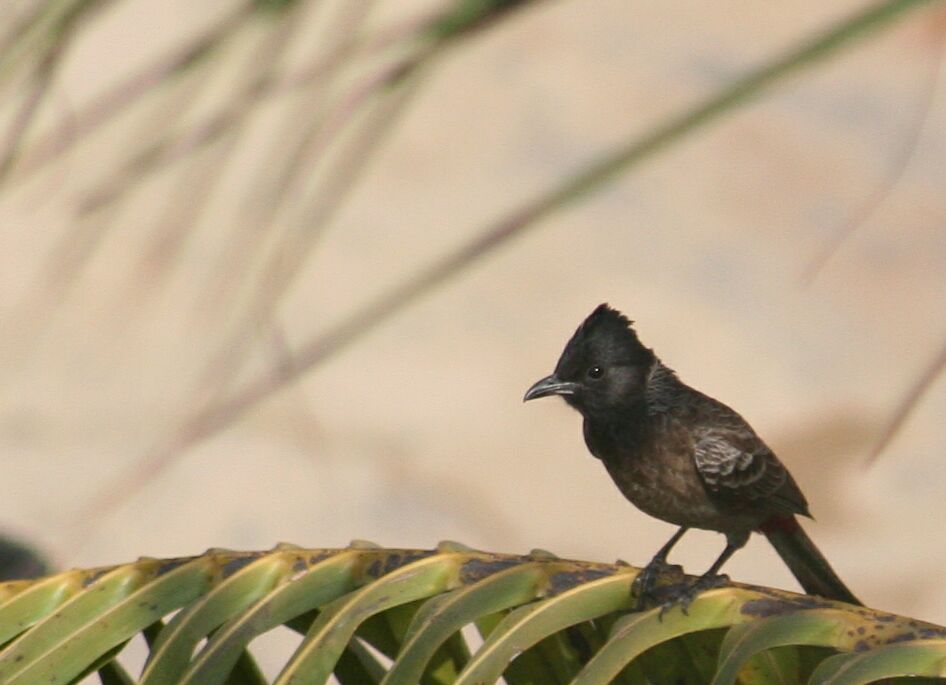
Here are some more images.
The "vent" is that red tuft at the bottom of the tail:
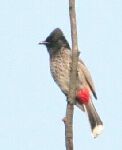
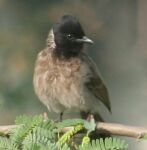
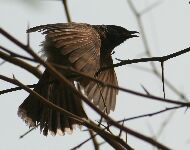
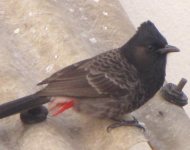
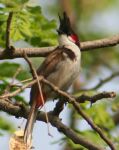
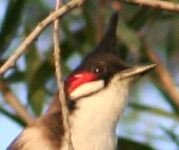
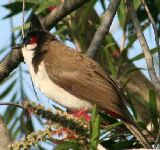
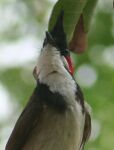
I have seen the rock chat singing away
in solitary splendour around
April-May, which may be their mating season. They can often be seen
on prominent roof corners of buildings, and are well-known for their
ability to mimic the songs of several species.
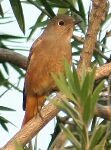
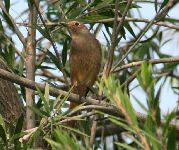
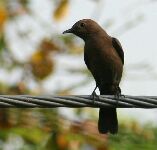
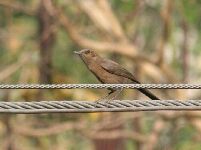
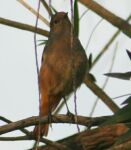
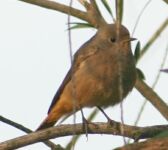

Pied Bushchat
The pied bushchat can be found all over campus. The male is bright black
and white, the female a more subdued buff-brown.
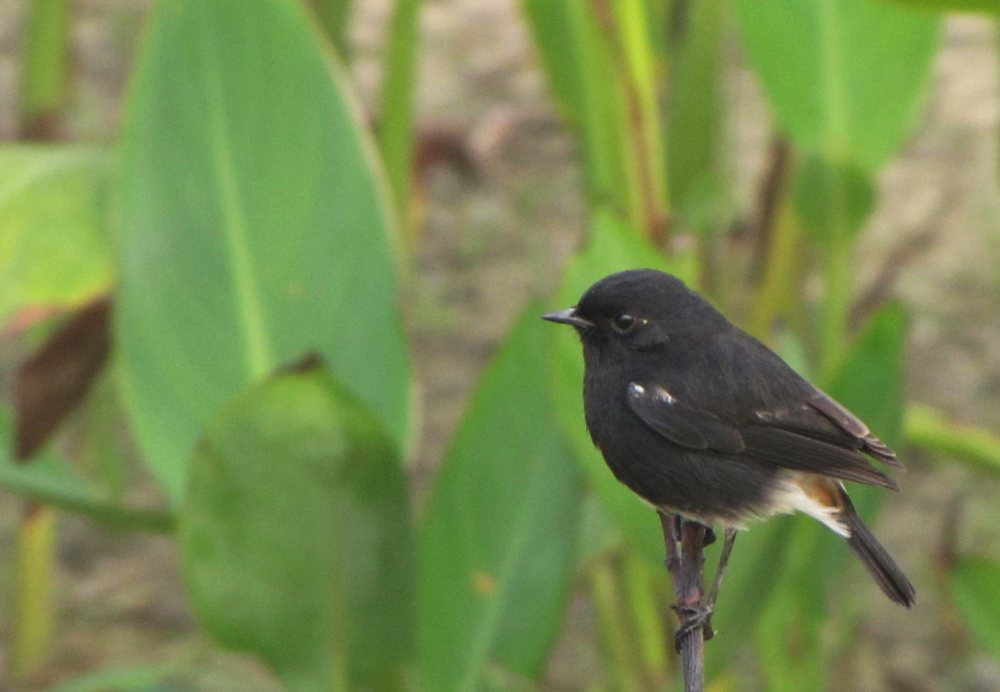
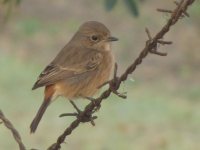
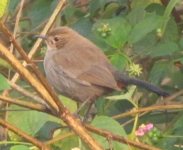
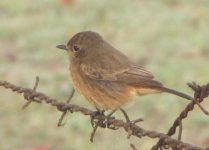
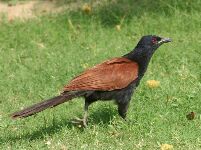
From close
up, it looks rather scary, with those huge talons (see the third image, 0277)
and the eyes and furry black head like something leftover from a horror
movie.
These images are of the same individual, who transited through my
garden almost every day for a few weeks in April 07.
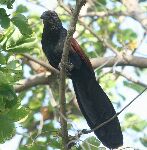
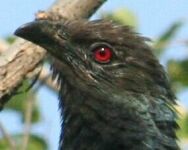
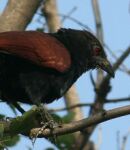
House Crow!
The commoner the bird, the less one feels like "wasting" energy on them...
(such are the laws of entropy). Perhaps the act of flight gives this
image a little distinction.
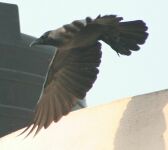
Cuckoo (Asian Koel)
One can hear them calling mellifluously in April May,
but finding them is harder.
Murphy's Law: They never call when you are looking at them.
Proof: You are so focused on looking through the lens that you can't hear.
One April morning the cuckoo to the left was sitting on a branch, serenading away to the world, when another male cuckoo quietly landed on the same branch to its right. There was a ritual sparring, after which the intruder flew off again. In photo 2857 the original inhabitant (to the left) is staring down the other.
The little egret has a darker beak than the cattle egret, and is rarely seen
away from water bodies. When I started this page, I had labelled these as
cattle egret, thanks to Ramit Singal for correcting it!
The hoopoe is commonly seen even in urban areas across India.
In IIT, it visits our
lawns, and can also be seen near
the Visitor's hostel. The fluffed up crest and the flip-flop flight makes
it rather remarkable, and one remembers it.
This one was photographed in Giridih, Jharkhand.
A pair of Hornbills have been regular visitors to the top branches of my
garden since last
November. They come from the West, around nine in the morning, sit amicably for
about half an hour, and wing on eastwards. 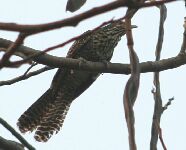
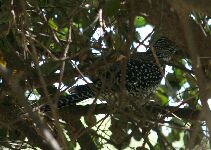
Black Drongo
These glossy black birds with a distinctive forked tail are fairly common in
IIT; they are less common in Delhi and are seen really frequently
as you go eastward. The third image is from Sainath, and catches a drongo
against a background of grass fires - it is
waiting for insects to fly out. Wet Drongos
These birds (and a couple of pied myna) would take off from their perch,
dive and splash into the jheel
and return back right away. Their flights were not deliberate as if they were
fishing or looking for food - it seemed to me that they were just having fun.
It was October
near Calcutta (off Kalyani Road) - not too hot either, but sunny.
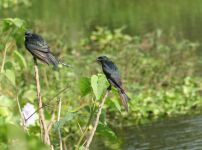
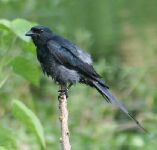
Cattle Egret
We have all seen these large snow-white birds hopping around in an ungainly
manner near
buffaloes or even sitting on them. Mostly they are looking for insects
turned over by the buffalo feet. The last two pictures from Sainath. The
rightmost one shows it in breeding plumage.
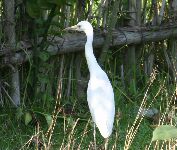
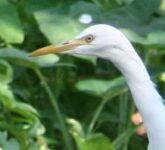
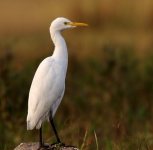
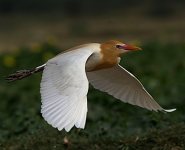
Cattle Egret on Water
I saw these Egrets flying along the
Lower Ganga canal running behind IIT, during a bicycle ride on
the morning of March 25, 2007. They are amazingly graceful in flight. Here
they are flying along with the Red-wattled Lapwing,
which is also commonly seen at the
reservoir near the mango grove (when it has water) and even on our lawns!
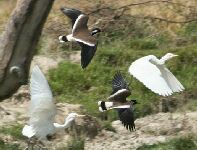
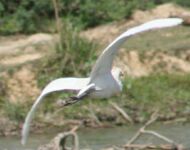
Little Egret
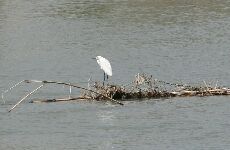
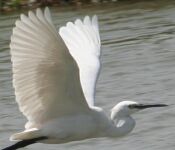
Hoopoe
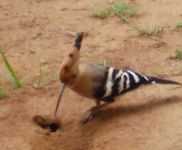
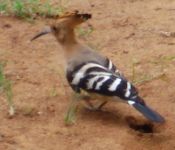
Grey Hornbill
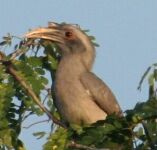
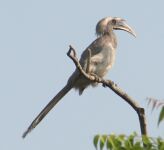
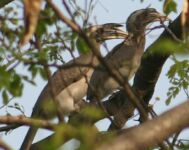
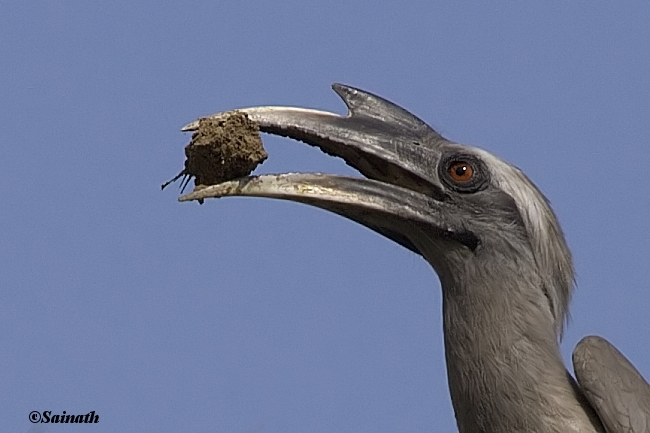 And now a fascinating image from Sainath. The hornbill uses mud and feces to
seal its nest; the female stays inside for the entire incubation and is fed
through a hole by the male.
And now a fascinating image from Sainath. The hornbill uses mud and feces to
seal its nest; the female stays inside for the entire incubation and is fed
through a hole by the male.
Common Kingfisher
This image is from Bithoor, by Sainath.
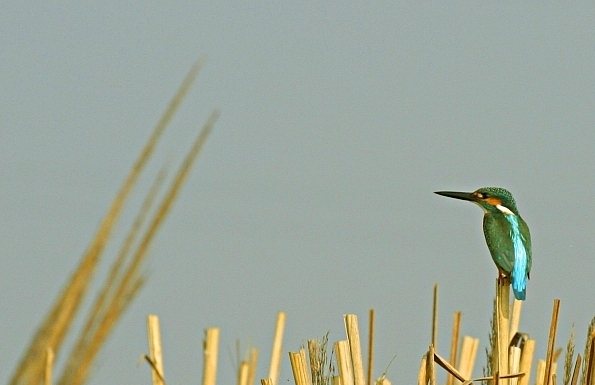
This is the bird that got me interested in bird photography - October 2005, Delhi. Image 3 (with the blue tail visible) is from the banks of the Ganga in Bithur. It is also called the White-Throated Kingfisher.
Large brownish kite, matched most features of Pariah Kite, which is the
most common raptor in urban areas. Sometimes the feathers may separate in
flight seeming like a tear (they are attached to the bone at the front of the
wing). The rest of the images are from a kite nesting family in Calcutta.
I have a small doubt about their ID though, because
the pariah kite is
supposed to have a forking
tail; this one shows it only in some views. Mostly though, the descriptions
match.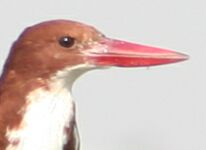
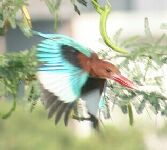
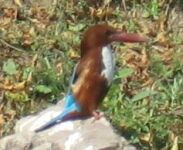
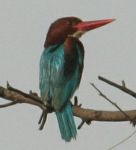
Pariah Kite
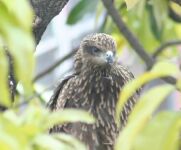 Next time around, there were two juveniles in the nest. When I shot this
photograph I thought there was only one bird, standing
prominently a little above the nest, but if you look closely you
can see the other
one - see if you can
find him? It is amazing how much their striped skin is meant to look like
the texture on the branch. He's
hidden in the foliage on the branch to the top right of the image,
looking down at the other nestling (you can
see the larger picture by clicking on the thumbnail).
Next time around, there were two juveniles in the nest. When I shot this
photograph I thought there was only one bird, standing
prominently a little above the nest, but if you look closely you
can see the other
one - see if you can
find him? It is amazing how much their striped skin is meant to look like
the texture on the branch. He's
hidden in the foliage on the branch to the top right of the image,
looking down at the other nestling (you can
see the larger picture by clicking on the thumbnail).
A large brown bird (somewhat larger than a pigeon) with a black head and
neck, brown and white colour, with thin yellow legs.
Often seen near water, along with other waterbirds.
However, a pair has taken up
residence on the roof of Prof. Gajbhiye's house (618), and terrorizes lane
32 with their loud call, day and night: "Did-you, Did-you, Did-you do it?",
especially if they see a dog or a cat.
The first image
[2041],
finds it sitting on the roof of
H. 618, which it colonized for much of 2007-08. Though there are don't seem
to be any water
bodies nearby, Prof. Gajbhiye is kind to them and often keeps his lawn wet,
and then these birds will sink down to the belly on the wet grass.
They often actively dig out earthworms from the ground.
In flight, The
V-shaped white stripe
(see image under Little Egret) is very distinctive.
Although this bird is quite common, and sports such brilliant colours,
it is relatively less known, being often mistaken for the common myna.
This species has been re-named "Brahminy Starling" at an international congress
with no representation from India. In fact,
the entire Myna range was renamed "Starling", throwing out a fact lamented
by Indian ornithologist J.C. Daniel in
Mynas love exploring holes, and this one in the gulmohar tree is a
favourite. The Brahminy enters head first, disappearing completely,
but manages to turn around inside the hole and re-emerge head first.
Occasionally, it might have an insect too...
And don't forget to read the story of the Brahminy
Swimming Pool.
Guava tree: In the guava season, it is hard to find a time when there
aren't some parakeets discreetly munching away on the tree. If you look at
this rose-ringed parakeet male, you will even find guava dribbling from his
beak! And it is even glaring at me, as if it's saying, "Impostor, get away
from my tree!"
Totas are known to be very smart animals. Like many other birds, use their
limbs very creatively. Here
you can see a tota holding a bottlebrush flower with one hand (oops,
claw). Finally, the story of a young
parakeet, who was a bit too greedy. On top of that, he
wasn't too smart, and he had a slight problem. Click on
this image or link to read the story of The
Foolish Tota on the Guava Tree.
The plum-headed parakeet has a yellow beak, and a thin blue tail
with a white tip. It is a bit smaller, is more yellowish-green, and has
quite a distinctive shape. The
head is distinctly reddish, as opposed to the full green on the
rose-rigned.
Red-Wattled Lapwing
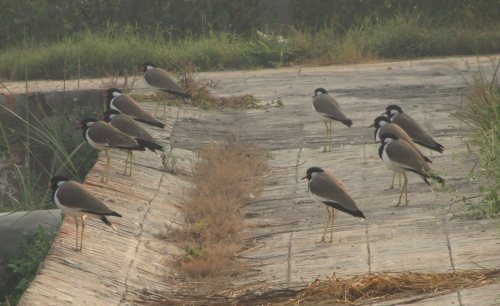
a flock of red-wattled lapwings at a corner of the oxidation tank near H8.
Dec 2009 Brahminy Myna
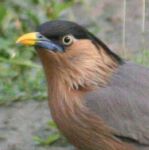
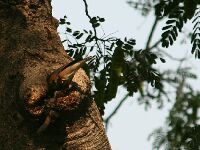
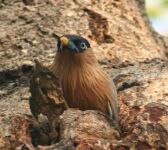
Pied Myna
These are more common in areas east of Kanpur - in Varanasi or
Calcutta, they are almost as common as house sparrows. In IIT, their are a
few nesting pairs on the large pipal tree near the Dhobi ghat, just
beyond the Yadav Taxi stand. This species is also called Asian Pied
Starling.
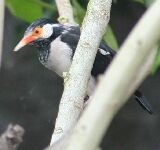
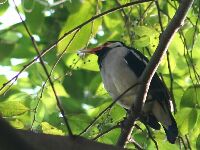
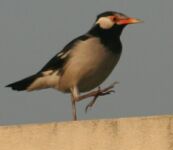
Bank Myna
This is very similar to the common myna, except it is gray and the black
crown is a sharper change in colour and not graded. This picture is from
Bithur.
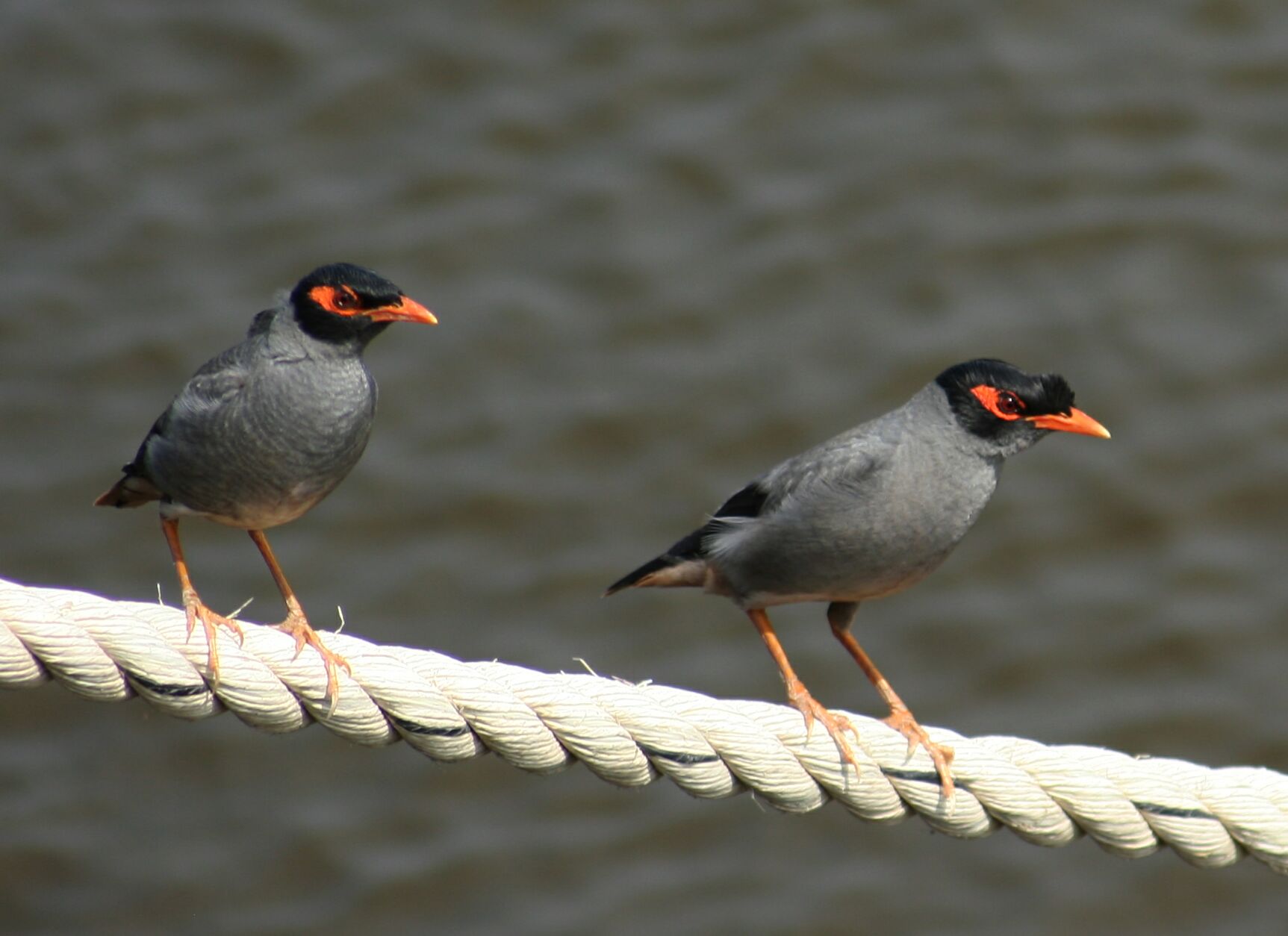
Common Myna
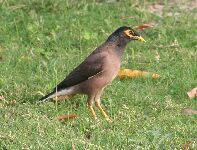
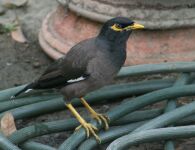
Rose-ringed Parakeet
The totA or the parrot is often seen flying by noisily and fast.
A great signal that my guava is ripe is when I discover them on the tree.
They can then be found on the top branches in noisy groups, positioning
themselves precariously to get at the fruit.
There are three species that you can see in IIT:
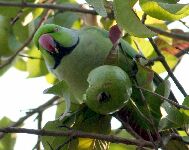
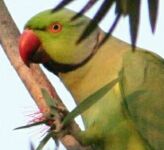
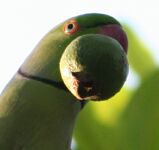
Plum-headed Parakeet

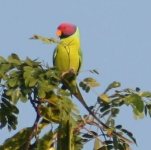
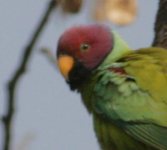
This dove has a half ring around the back of the neck. Here it is trying to
engage a brahminy myna in conversation at the top of a babool tree. The
second image, due to Sainath, has them involved in a morning argument.
This has a stippled pattern on the wings, and also on the back of the neck
(rather than on the
sides for the Laughing dove). It is yet another bird that is more common in eastern India.
Amazingly, no sparrow ever visits my garden. I have seen them in Kanpur city though,
e.g. on the tracks at the railway station.
Sparrows (like most birds) are
masters at hopping (middle image). These had me foxed for a long time. Though these birds look like several
different species, it turns out that
the male Purple Sunbird changes its plumage dramatically over the
year. Sunbirds and hummingbirds both have curved beaks and a hovering style
of feeding, but they aren't related - these features are just an example
of convergent evolution.
/P>
Collared Dove
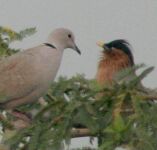
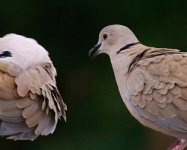
Laughing Dove
This dove, also known as the Little Brown Dove, has what Salim Ali calls "a
miniature chessboard" in brown or black on both sides of the neck (see middle
image below).
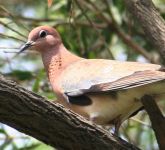
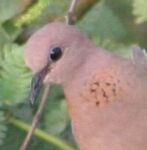
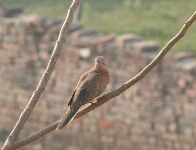
Spotted Dove
Blue Rock Pigeon
This is the most common pigeon in all cities. Have you noticed how it
prefers to be at the very edge, on the precipice, rather than in safer spots?
That's because it's natural habitat used to
be cliffs and coastal crags. Looking at this picture, you will realize that
pigeons believe God created humans so pigeons could have more cliffs
to jump off from!
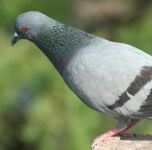
Peacock
The peacock strutting about with its impossibly long tail poses a mystery - why
would evolution tolerate a development which is clearly a hindrance?
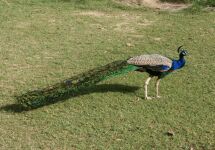
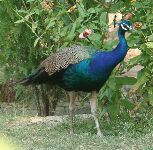
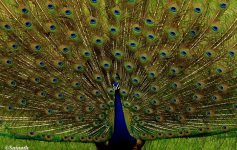
1. The male's long dysfunctional tail just before the rains (April).
2. It has become barely a stub in the non-breeding season (October).
3. (photo:Sainath): The peacock's spectacular display
highlights the length of its tail. Individuals with longer tails attract more
mates.
We may conclude that...those males which are best able by their various charms
to please or excite the female, are under ordinary circumstances accepted. If
this be admitted, there is not much difficulty in understanding how male
birds have gradually acquired their ornamental characters...
The wasteful tail is an honest
indicator of the individual's "fitness", so that the female who chooses to
mate with it is assured of a high-quality gene.
Some people think that by analogy, human brains may be a peacock's tail, they
are quite unnecessary and expensive, and may only serve for being attractive to the
opposite sex. See this article
I wrote some years ago in my column Storytelling Science in the
Hindustan Times. 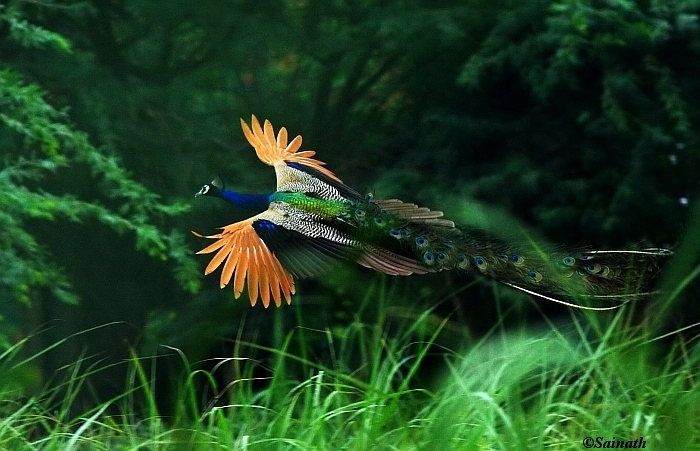
An exceptional image of a peacock in flight from Sainath.
Magpie Robin
These good looking birds are also common in Bihar and Bengal - it is the
national bird of Bangladesh (doyel). You can hear its lively cheep sound,
which it
utters with its beaks open and body tensed up... It is especially visible in
the springtime, when (perhaps the male?) positions itself prominently, and sings away
for hours. 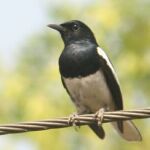
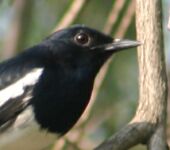
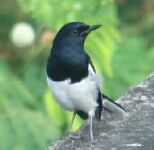
Indian Robin
Saw this on my lawn a couple of times in Oct 2006, and many time since then.
Common House Sparrow
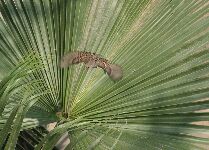
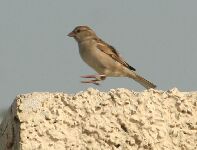
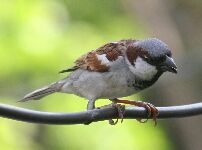
Purple Sunbird
Purple Sunbird - Female
Purple Sunbird - male, non-mating (eclipse) plumage
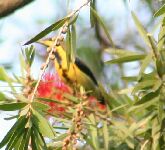
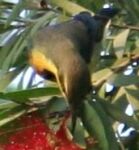
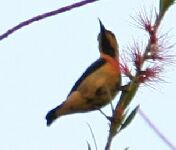
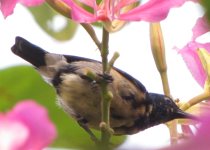
The fourth image (0584, from Kolkata, Dec 09) is either in-between moults, or
it may be a different species.
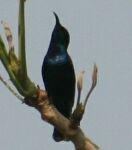
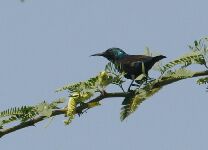
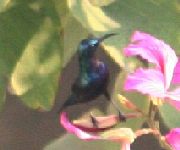
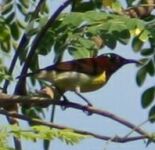 More about [How I discovered sunbirds].
More about [How I discovered sunbirds].
The tailorbird is a rather common bird, but I find it a bit
difficult to distinguish from many of the warbler-like species on campus.
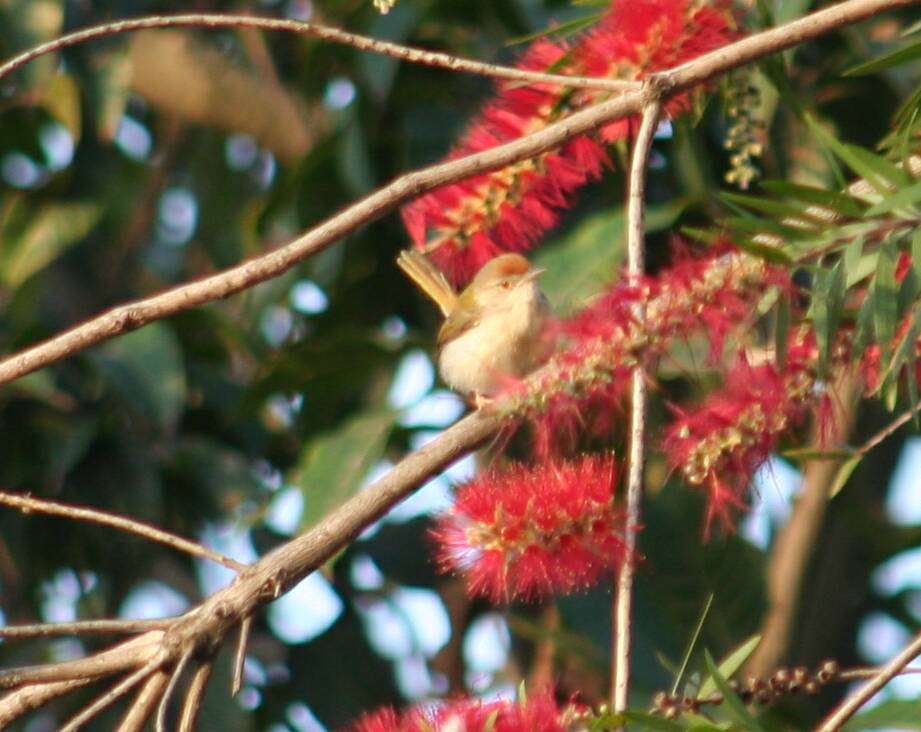
I saw this only one day, that also for a few minutes. Thanks to
B. Ravindran for ID'ing it. It is now called the Black-rumped Flameback.
This tiny restless bird is a frequent visitor, sipping on the flowers.
Even if you can't make out the white ring around the eye, you cannot mistake
the yellow-orange colour, and the tiny size, as it jumps from branch to
branch, sometimes in small groups. Getting a white-eye to sit long enough
for you to photograph it is a rarity.
These images are from the bottlebrush tree in October, and from a Delhi
park in April. These are just the most common birds that one sees, the ones (I think) I
have been able to figure out.
There are many more birds on campus, that one sees less frequently. In the
page
Less Common Birds, I list some of these:
There are a whole lot of other birds that one sees on campus, but I just don't know their
names. Please check up on them at
this page of Unidentified Birds.
Rufous Treepie
Though this is quite a large bird and a common visitor to my garden, it is
very jittery and not easy to photograph. It's a rather noisy bird - notice
it calling in flight.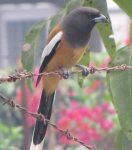
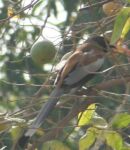
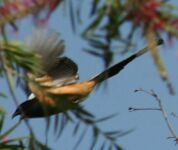
Lesser Golden-backed Woodpecker
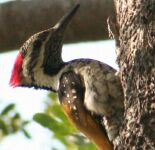
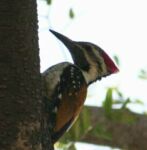
The beautiful image next is from Sainath.
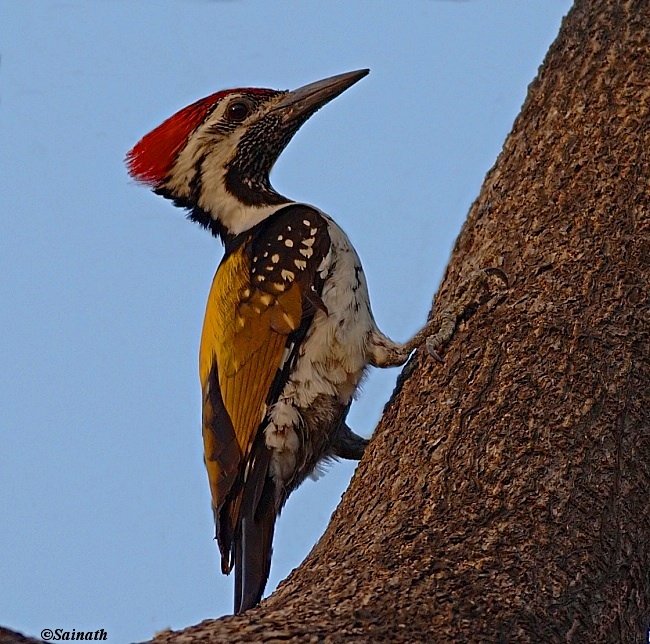
White-Eye
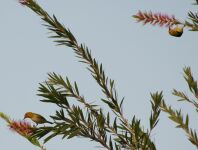
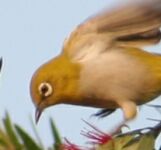
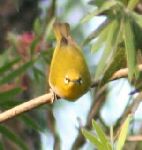
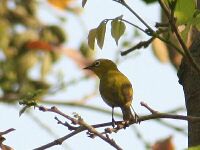
Unidentified birds
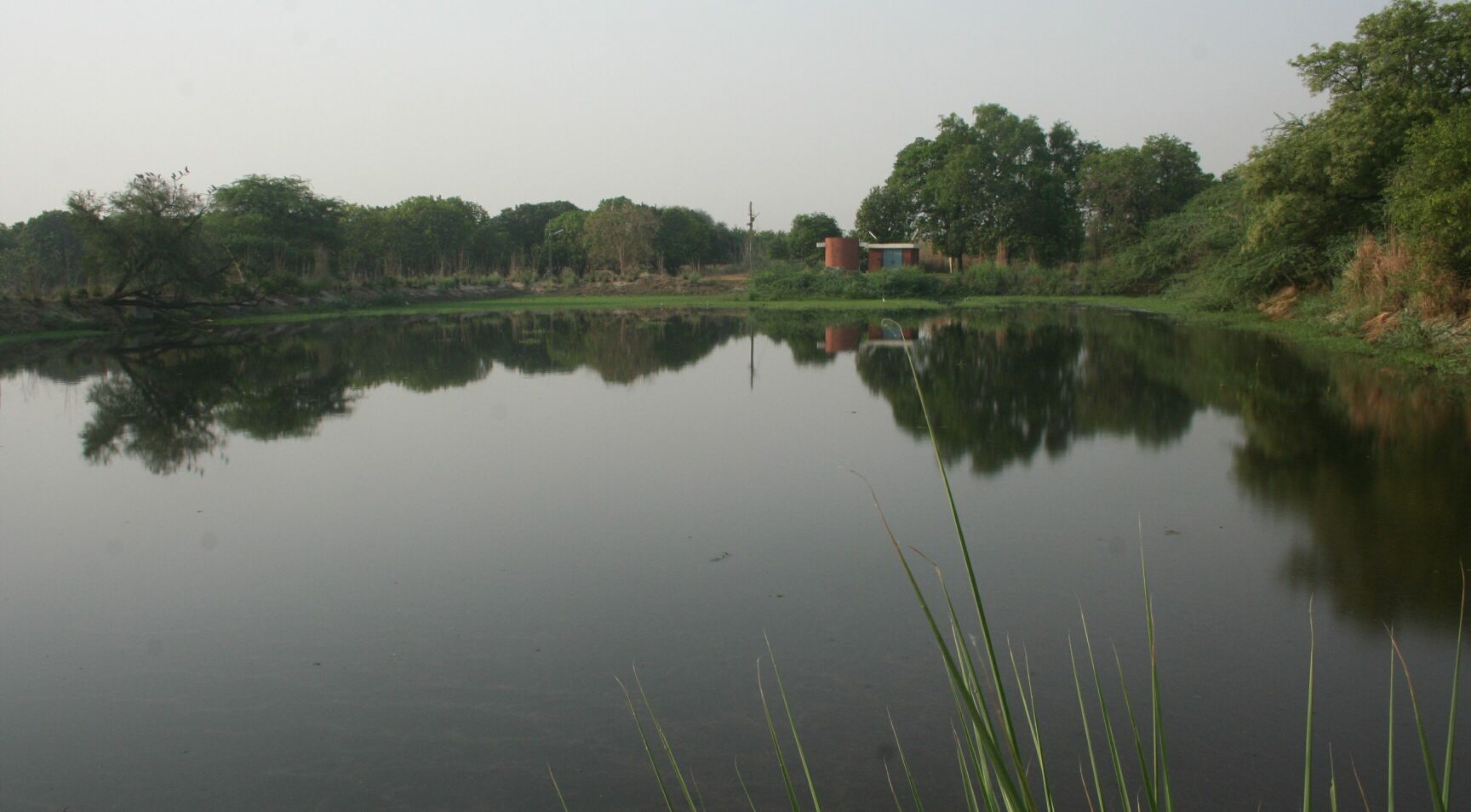
In the last two years, the pump that fills this tank with waste water has been malfunctioning (yes, that long!), so the reservoir has gone completely dry. The pond has become dense muddy jungle, and birdlife has also gone down. As of January 2010, however, I was told that the pump has been repaired, but it will be a many months before the pond comes back...
 Meanwhile,
the oxidation
tank near hall 8 is worth a visit. The perimeter road running beyond
it is also worth a visit.
Meanwhile,
the oxidation
tank near hall 8 is worth a visit. The perimeter road running beyond
it is also worth a visit.
Birds are tricky to photograph. They are never still, and they will move, as if with great deliberation, between locations with great lighting disparity, e.g. from a background of foliage to where they are silhouetted against the bright sky.
Also, the work begins only after you have taken the actual photo. Thank heavens for the digital era, but now you have the problems of plenty. You have to collate the images, sort them by quality, bird name, venue, time, etc. You have to crop, cut, and resize them. And if you are planning to make webpages, you have to create thumbnails ... the work is endless. And it can be very very consuming. Very detrimental for a normal civilized existence.
Nonetheless, there is great satisfaction in it of course, which is why the breed of bird photographers is constantly increasing.
Note on Camera: Most of the pictures on this website were taken on the Canon EOS 350D DSLR with a Canon 55-200 f4.5-5.6 lens. However, I would not recommend a zoom lens for such photographs, a fixed telephoto, 300mm or higher, with image stabilization, may be better (Sainath uses a 400mm lens). But these lenses are rather unwieldy, and the cost, around Rs. 1 lakh, can be prohibitive. I have recently got a superzoom compact camera - the Canon SX20IS; with the lens going to 560mm, this is quite a competent alternative, in a much more compact format.